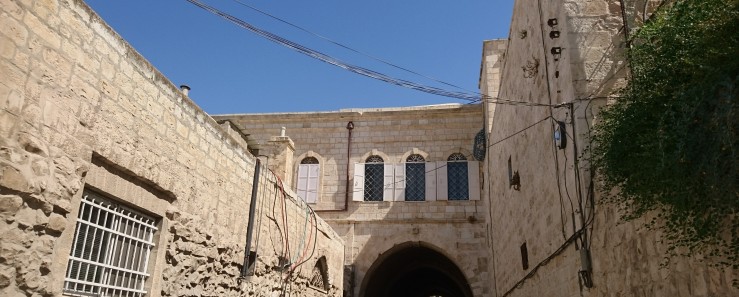
One of the highlights of a student trip to Jerusalem last summer was a tour through the Armenian compound. I’d been visiting the Armenian St. James Church a number of times, usually when the vespers were sung and the church is open for the general public. This time, with the help of someone within the Armenian community, we were able to secure a guided tour over the complex.
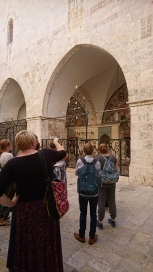
The Armenian compound in the Old City of Jerusalem has roots going back a long time – in Crusader period already a considerable part of the area was in Armenian hands. According to Armenian tradition, an Armenian bishop – later patriarch – resided in the city already in the fourth century. Over the centuries, the compound waxed and waned till it reached its current size. On the north side it borders the complexes of some other Christian communities, the Lutherans, the Anglicans and the Syriac Orthodox, all much smaller than the Armenian compound, and usually considered part of the ‘Armenian Quarter’. On the east it touches the Jewish quarter. Different from the three other so-called quarters of the Old City , most of the Armenian quarter is walled off, and it is impossible to wander through its alleys without someone from the Armenian quarter to accompany you. For most of the centuries monks and clerics lived here, praying and learning close to the most holy places of Christianity in the Holy City were Christ lived, died and rose from the dead. While the Armenians have their own church and chapels in the quarter, they share, with the Catholics and the other Eastern and Oriental Orthodox Christians the use of the Holy Sepulcher/Church of the Resurrection, the Church of the Tomb of the Virgin Mary, and the Church of the Nativity in Bethlehem. At the appointed times, Armenian clergy can be found celebrating the liturgy, confirming their presence in the Holy City beyond the walls of the compound.
Their presence beyond the walls is also visible in maps that are pasted on the outer walls of the compound, along one of the busiest streets in the Old City, maps that trace the genocide of 1915 with small and large red dots and arrows indicating the routes of deportation. It is the genocide on the Armenians of the Ottoman Empire that fundamentally changed the make-up of the Armenian quarter in Jerusalem. Soon after the war, orphans from Turkey who, surviving death marches into the Syrian desert, had ended up in Syria and Iraq, were send to Jerusalem that by then was under British rule – later to become British Mandate Palestine.
Thus the Armenian compound became a crowded refugee camp that gradually transformed into a thriving but rather cramped neighborhood, with basic facilities such as schools and healthcare within its walls. Over the last decades, the number of people started to diminish. Partly because some chose to live outside the walls, joining other Palestinian Armenians who had been living there for a long time already, others because they migrated abroad, to the US, Canada or elsewhere. However, until today, descendants of the refugees live here, in the safety of the walled-off compound, with strong doors that close in the evening. Until today, the compound not only includes family housing, the living quarters of the monks and the patriarchal offices, but also a health clinic, the Calouste Gulbenkian Library with a world-renowned collection of Armenian scholarship, and a school which nowadays accepts also children from other Christian communities, provided they are willing to adapt to the Armenian context. In a separate part of the compound is also the patriarchal seminary, where students from all over the world come for their theological training. Unfortunately the museum has been closed for many years.
One of most impressive elements of the compound is its cemetery. As those familiar with Jerusalem would know, the city is surrounded by cemeteries – Muslims and Jews highly value the possibility to be buried near the walls of the Holy City, seen as a first rank location on the day of the Resurrection. Among Christians it is less common for those who do not live there to have yourself buried in the Holy City, but over the centuries a number of Christian graveyards have catered for decent burial of Christian Jerusalemites. The Armenians have their own cemetery as part of the compound, much larger than one would expect when walking alongside its high walls, and full of graves packed together. Beautiful tiled decorations, Armenian epitaphs and photographs of the deceased make it a moving visit that confronts one with the difficult lives of the Armenians of Jerusalem as much as with the enduring power of the beauty of graves well cared for.
At the time of our visit, a new church was being built on the premises, which due to permit-troubles could not yet be completed. At the grounds of the seminary, not far from the cemetery, the compound’s genocide monument has been erected – as in all Armenian churches and monastic complexes. Seven kachkars, the characteristic Armenian crosses with intricate stone carvings, refer to the seven major places in Anatolia where Armenians were rounded up, killed and deported from to the Syrian desert.
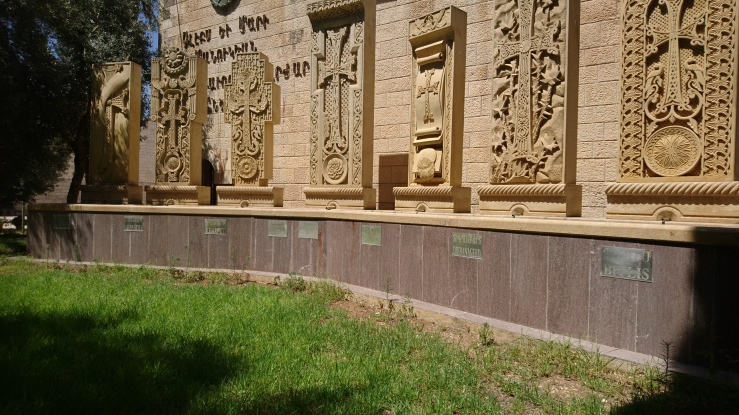
A hundred years after the first orphans came to live in the compound, the area slowly returns to its mostly monastic function in the Holy City – monastic however in the Oriental Orthodox way, in which monasteries are as much a center of pilgrimage, piety and learning as they are of community and community service – a center, therefore, where the remaining lay families can continue to live in safety. One may hope that in addition to its very important service to its inhabitants, its students, its Armenian visitors from abroad and tourists from everywhere, it will remain a place where the checkered history of the twentieth century, of massacre, expulsion and diaspora and resettlement, will be remembered through its very visible remains in Jerusalem’s Armenian Quarter.





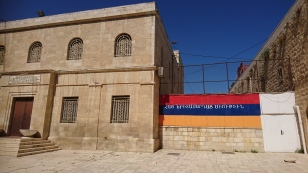

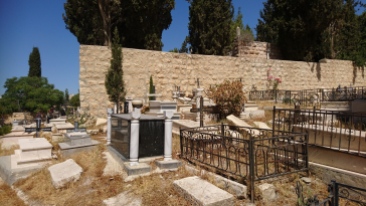







[…] By Heleen Murre-van den Berg Professor of Global Christianity, director Institute of Eastern Christian Studies (hlmvandenberg.me) […]
LikeLike